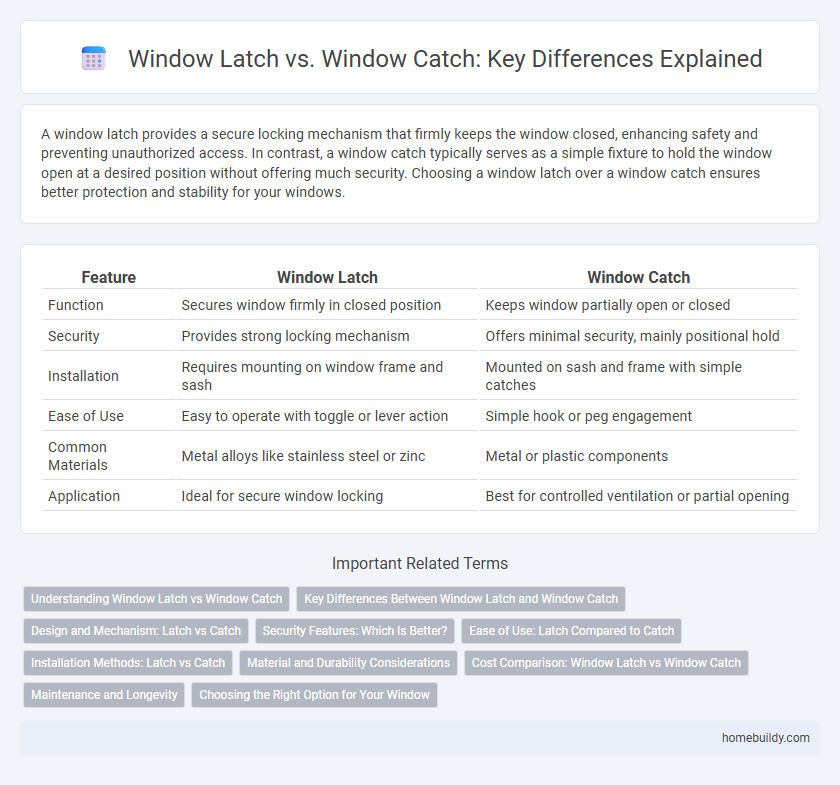A window latch provides a secure locking mechanism that firmly keeps the window closed, enhancing safety and preventing unauthorized access. In contrast, a window catch typically serves as a simple fixture to hold the window open at a desired position without offering much security. Choosing a window latch over a window catch ensures better protection and stability for your windows.
Table of Comparison
| Feature | Window Latch | Window Catch |
|---|---|---|
| Function | Secures window firmly in closed position | Keeps window partially open or closed |
| Security | Provides strong locking mechanism | Offers minimal security, mainly positional hold |
| Installation | Requires mounting on window frame and sash | Mounted on sash and frame with simple catches |
| Ease of Use | Easy to operate with toggle or lever action | Simple hook or peg engagement |
| Common Materials | Metal alloys like stainless steel or zinc | Metal or plastic components |
| Application | Ideal for secure window locking | Best for controlled ventilation or partial opening |
Understanding Window Latch vs Window Catch
A window latch secures a window by locking it into place through a mechanical fastener, providing safety and preventing it from being opened from the outside. A window catch, in contrast, functions primarily as a catch or stopper that holds the window in an open or closed position without a locking mechanism. Understanding the difference between a window latch and a window catch is crucial for selecting the right hardware based on security needs and operational functionality.
Key Differences Between Window Latch and Window Catch
Window latches provide a secure locking mechanism designed to firmly hold windows closed, enhancing safety and preventing unauthorized access. Window catches primarily function as holders that keep windows slightly open or in place, offering ventilation without fully securing the window. Key differences include latches emphasizing security with locking capabilities, while catches focus on stability and partial opening support.
Design and Mechanism: Latch vs Catch
A window latch features a rotating or sliding mechanism that securely locks the window in place, offering enhanced security and ease of operation. In contrast, a window catch typically involves a simple hook or lever that holds the window open or closed but does not provide the same level of locking strength. The design of window latches prioritizes durability and weather resistance, making them ideal for exterior windows, whereas catches are often used for interior windows or lightweight sashes.
Security Features: Which Is Better?
Window latches offer enhanced security features by providing a stronger locking mechanism that firmly secures the window frame, reducing the risk of forced entry compared to window catches. Unlike window catches, which mainly keep windows closed without robust locking capabilities, latches incorporate durable metal components and locking points engineered to withstand tampering. For optimal home security, window latches are recommended due to their superior resistance to break-ins and increased reliability in protecting against unauthorized access.
Ease of Use: Latch Compared to Catch
Window latches provide a more straightforward mechanism for securing windows, typically involving a simple lever or rotating action that requires minimal effort. Window catches often involve sliding components or spring-loaded parts that can be less intuitive and require more precision to operate. The latch design prioritizes ease of use, making it especially suitable for frequent opening and closing of windows without compromising security.
Installation Methods: Latch vs Catch
Window latches typically require screw installation directly onto the window frame for secure fastening, providing a tight seal and enhanced security. In contrast, window catches often use simpler mounting methods, such as clips or adhesive pads, allowing for quicker, less invasive installation but potentially less durability. The choice between latch and catch installation depends on the desired balance between ease of setup and long-term stability.
Material and Durability Considerations
Window latches are typically made from robust materials like stainless steel or brass, ensuring high resistance to corrosion and enhanced durability in various weather conditions. Window catches often use lighter metals or plastic components, which may offer less longevity but are suitable for interior or less demanding applications. Choosing a window latch over a catch generally provides greater security and a longer lifespan due to superior material strength and build quality.
Cost Comparison: Window Latch vs Window Catch
Window latches generally cost more than window catches due to their more complex locking mechanisms and enhanced security features. Window catches are typically simpler devices, making them more affordable but offering less robust security. When budgeting for window hardware, choosing a window catch can reduce initial expenses, while a window latch may provide better long-term value through improved safety and durability.
Maintenance and Longevity
Window latches require regular lubrication and tightening to ensure smooth operation and prevent wear, while window catches generally demand less frequent maintenance but may be prone to loosening over time. Proper upkeep of a window latch, including cleaning and rust prevention, significantly extends its longevity compared to a window catch. Choosing materials like stainless steel or brass for either mechanism enhances durability and reduces the need for frequent replacements.
Choosing the Right Option for Your Window
Selecting the ideal window latch or window catch depends on factors such as security level, ease of use, and window type. Window latches typically offer enhanced security by tightly locking the window frame, while window catches provide simple hold-open functionality and ventilation control. For optimal safety and convenience, consider metal latches with robust locking mechanisms for exterior windows and lightweight catches for interior or secondary windows.
window latch vs window catch Infographic

 homebuildy.com
homebuildy.com